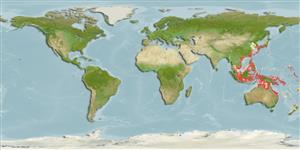分類 / Names
共通名の | 類義語 | Catalog of Fishes(部類, 種) | ITIS | CoL | WoRMS | Cloffa
Environment: milieu / climate zone / depth range / distribution range
生態学
海 関連する礁; 深さの範囲 10 - 40 m (Ref. 90102). Subtropical
Indo-West Pacific: southern Japan to Queensland and Western Australia.
サイズ / 重さ / 年齢
Maturity: Lm ? range ? - ? cm
Max length : 11.0 cm TL オス/雌雄の選別がない; (Ref. 42740)
背面の脊椎 (合計) : 5; 背鰭 (合計) : 20 - 21; 肛門の骨: 1 - 16; 臀鰭: 18. This species is characterized by the following: D V,20-21 (usually 21); A I,16-18; 13-15 (rarely 13, usually 14) pectoral rays; 38-43 lateral-line scales; about 2-4 + 7-10 gill rakers; about 4 predorsal scales; ctenoid scales on cheek, in 4 horizontal rows; front of lower jaw with 8 canine teeth; vomerine teeth a broad chevron-shaped patch; with palatine teeth; upper edge of subopercle with a prominent sharp spine; serrae on opercular bones absent; body depth 4.15-4.75 in SL (21.20-24.1% SL); middle dorsal spine longest; membrane from last dorsal spine joined near base of first soft ray; body gray to reddish dorsally, white below with the edges of scales gray; a series of f5 broadly U-shaped dark brown bars on back, smaller posteriorly, or with a series of 5 double dark brown to black dashes, the anterior 2 with 1 above and 1 below lateral line; a series of 9 spots or short bars on lower side of body that may be blackish, reddish, or dusky yellow; small dark reddish spots, one per scale, often present scattered along side of body and on cheek; presence at side of snout of an iridescent pale blue line, and one beneath eye; lips with large dark blotches; usually presence of a midventral blackish spot on isthmus, often with a smaller black spot to each side anteriorly; edge of chin below lower lip dusky to blackish; spinous portion of dorsal fin may be entirely black, but usually blackish with large pale yellowish blotches in outer part; soft dorsal fin with rows of black to black-edged orange spots, the base of most rays black or with black upper ends of U-shaped marks extending into base of fin; anal fin base with a row of red spots, a red submarginal line, and a small black spot on penultimate membrane about one-third distance to margin; caudal fin with small blackish, dusky orange, or red spots, often with smaller white spots as well (Ref. 57562).
Found in silty sand and rubble areas near reefs at depths of 10-40 m (Ref. 2334, 90102).
Life cycle and mating behavior
Maturities | 繁殖 | Spawnings | Egg(s) | Fecundities | 幼生
Pelagic spawner. A monandric species though some small males may develop directly from juveniles indicicating diandry (Ref. 103751).
Randall, J.E., G.R. Allen and R.C. Steene, 1990. Fishes of the Great Barrier Reef and Coral Sea. University of Hawaii Press, Honolulu, Hawaii. 506 p. (Ref. 2334)
Human uses
用具
特記事項
XMLをダウンロードして下さい
インターネットの情報源
Estimates based on models
Preferred temperature (Ref.
123201): 20.5 - 29, mean 27.7 °C (based on 326 cells).
Phylogenetic diversity index (Ref.
82804): PD
50 = 0.5000 [Uniqueness, from 0.5 = low to 2.0 = high].
Bayesian length-weight: a=0.00692 (0.00311 - 0.01538), b=3.06 (2.88 - 3.24), in cm total length, based on LWR estimates for this Genus-body shape (Ref.
93245).
栄養段階 (Ref.
69278): 3.4 ±0.4 se; based on size and trophs of closest relatives
回復力 (Ref.
120179): 高い, 15か月以下の倍増期間の最小個体群 (Preliminary K or Fecundity.).
Fishing Vulnerability (Ref.
59153): Low vulnerability (10 of 100).
Nutrients (Ref.
124155): Calcium = 90.1 [38.9, 189.0] mg/100g; Iron = 0.838 [0.441, 1.526] mg/100g; Protein = 18.7 [16.4, 20.8] %; Omega3 = 0.165 [0.085, 0.313] g/100g; Selenium = 14.1 [5.7, 32.1] μg/100g; VitaminA = 64.2 [17.8, 236.7] μg/100g; Zinc = 1.23 [0.73, 1.95] mg/100g (wet weight);
